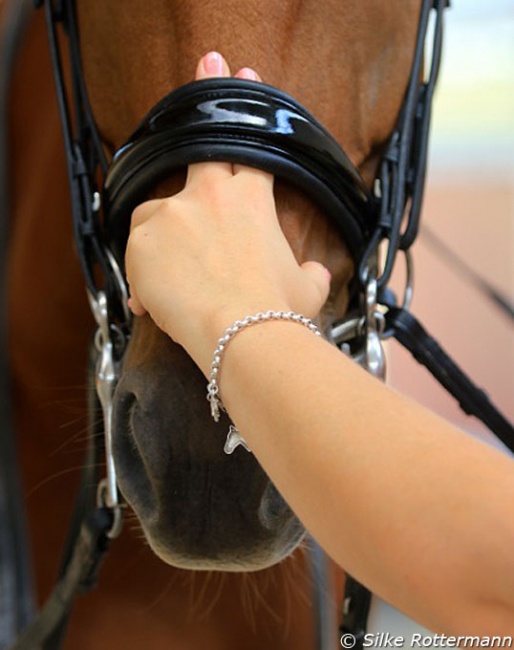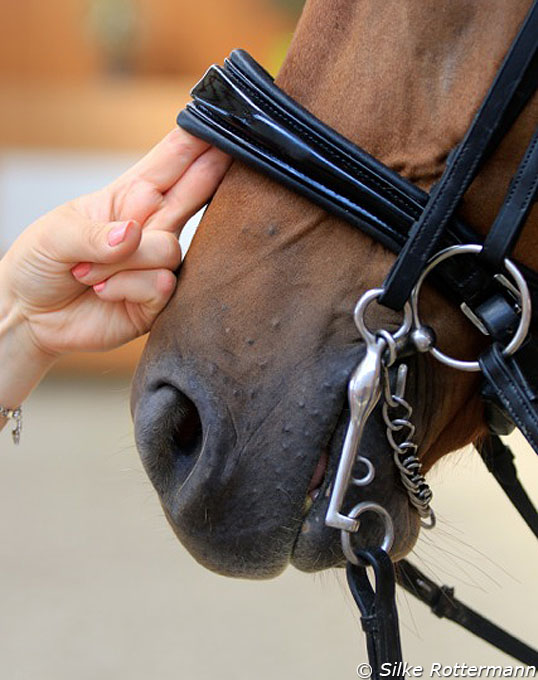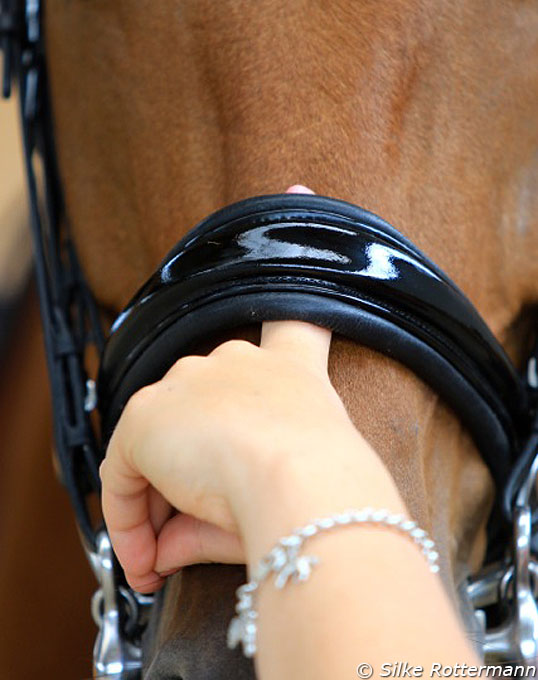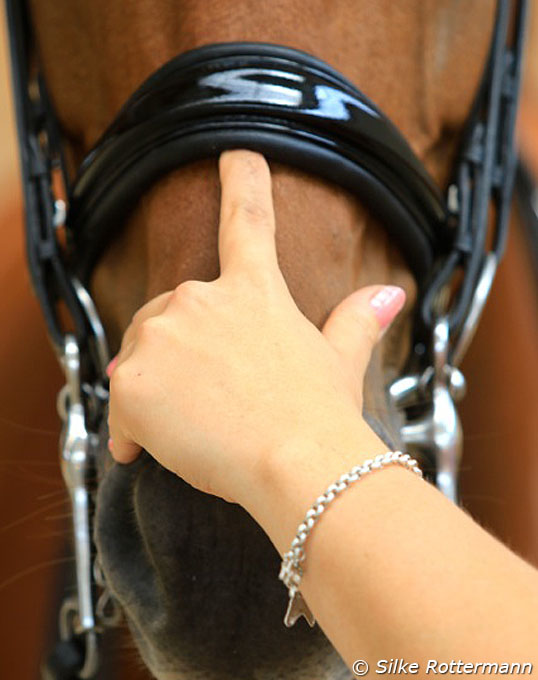
When the news broke that British Charlotte Dicker had received a yellow card for overtightening the noseband on Sabatini in the individual test at the 2018 European Young Riders Championships, a huge discussion erupted about animal welfare and especially vague FEI rules. What is particularly delicate in this case is that the rider, according to her own statement, had used the same fitting of the noseband in the team test, but there were no issues about tightness then.
Even if her horse's noseband wasn't as loose as it should be, one cannot get rid of the feeling that Dicker, who is the grand-daugher of Britain's dressage legend Jennie Loriston-Clarke, has become the scapegoat for the FEI's questionable noseband measurement rule. She as a single person is now in a center of public discussion where others with tight nosebands pass by FEI stewards.
Too tight cavessons are still a pretty common sight at international shows with all their consequences. A decisive reason why stewards might hesitate to act more often and more consequently, is that their decision to intervene is now based on a very wishy-washy rule, that can easily be disputed.
The Rules
I am sure everybody will agree that rules only make sense under three conditions: They are clear, they are precisely applicable and they are respected by all who play the game.

many classical dressage lovers
The FEI Code of Conduct for the Welfare of the Horse states that "Tack must be designed and fitted to avoid the risk of injury and pain" and based on it, the dressage rule-book regulates in article 428 („Saddlery“) that "a cavesson noseband (…) must never be as tightly fixed so as to harm the horse." In a message of the FEI to its national federations in 2016 it says to "pay particular attention to ensure that nosebands are not overtightened. It must be possible to place at least one finger (index) between the horse's cheek and noseband."
To sum up: Tack isn't allowed to harm the horse, but to ensure that it is enough to squeeze one index finger of whatever size between the horse's cheek (not nasal planum!) and the noseband to assure this. I guess I am not the only (rider) who asks herself how his makes sense. It doesn't require rocket science to recognize that this is not working in several regards.
Firstly the measuring rule on the cheek and not the nasal planum make the entire question of noseband tightness redundant: cavessons can still be tightened, not to say overtightened without breaking the measurement rule. Because the padding of these modern nosebands as well as the anatomy of the horse's cheek makes it possible to still squeeze at least an index finger of average size between both.

was tightened so that just one finger
was able to be pushed on the nose.
This is how the NZL federation wants it.
However, more importantly the vague FEI rule makes a steward's job more than hard as s/he is of course aware how imprecise it is and how disputable their decision might be afterwards.
The Modern Cavessons
With some strength it is pretty easy to crank any noseband that can be found on the market. It is undeniable that the invention of the "Swedish cavesson" with its pulley system, which has conquered almost the entire market of double-bridles the past 15 to 20 years, has made it extraordinarily easy to severely tighten them.
The market creates always new versions for more comfort: new cuts, new designs, more padding, but some cavessons we see today have doubled in width as well as in thickness compared to what was common until the 1990s. Another remarkable trend noticed with noseband "fitting" is that now there is an increasing number of riders who position their cavessons against the horse's cheekbone. Talk about discomfort!

on the nose possible
The last research which caught the attention was led by Professor Paul McGreevy (among others) of the University of Sydney („The Effect of Noseband Tightening on Horses' Behavior, Eye Temperature and Cardiac Response“). It proves the relation between a cranked cavesson in a double-bridle and significant signs of stress in the horses wearing them.
Other consequences are ulcers inside the mouth (as the cavesson is pressing the mucous membranes into the molars), tongue problems of all sorts (because the horse cannot escape the too big pressure of the curb), horses biting their lips or tongues especially in competition tests, or in extreme cases even deformed nasal planums. All these well known issues with ill fitting nosebands have so far caused no significant change in the current FEI measurement rule.
No matter what the market or even some „experts“ want to make us believe: no padding in the world prevents the negative effects of cranked nosebands and extra padding of the cavesson is totally unnecessary if the horse wears a fitting noseband!
The Public Eye

for one finger on the nose like that
The national federations of Denmark and New Zealand have reacted and released rules which became valid this year. They regulate the tightening of a noseband. While in Denmark a standardized taper gauge is used, making sure there is at least 1.5 cm between the nasal planum and the noseband, New Zealand asks one finger between both.
Both rules have been welcomed by the equestrian community with much applause and some relief. However, the Danish rule says that the steward only acts in cases of doubt which again leaves room for not every rider being treated the same way. Furthermore there is the fact that 1.5 cm or one finger hardly match the „two-finger-rule“ which had been recommended and was considered standard in several countries for a long time, among them Germany where the guidelines of 2014 still speak of two fingers between noseband and nasal planum.
Where is the root of this evil and how to go turned it around? It is simple ! Stricter, clearer and standardized rules would surely help and moreover force certain riders to change their riding habits (for the better).

look what is still possible !
Here it is up to the judges to rethink their attitude: There is a huge difference between a horse gaping due to resistance in the mouth or one slightly opening the mouth by gently chewing the bit. Up until 1958 the FEI rule-book even stated that a slight mobility of the horse's chewing in all gaits is considered a guarantee for submission.
Justice for All
'In dubio pro reo'. With a rule so imprecise and a measurement as vague as an individual index finger, it endangers the level field of play in the sport. Riders like Charlotte Dicker remain one of comparatively few cases. She now had to go through public hell as we live in times where factual discussions are replaced by heated bashing on social media.

⇒ To strengthen the stewards`position to do their job in a clear and indisputable way.
⇒ To guarantee justice, with everybody having to undergo the same standardized measurement.
⇒ To filter out those riders who crank their horse's mouth shut to mask their training inadequacies with harmfully adjusted tack.
⇒ Last not least, for the sake of the horses and this beautiful sport.
What does the Code of Conduct say?
„Welfare of the horse must never be subordinated to competitive or commercial influences.“
So go ahead FEI, in favour of more clarity, more justice and less overtightened nosebands!
Text and Photos © Silke Rottermann
Related Links
Charlotte Dicker Yellow Carded for Overtightened Noseband
Noseband Special: Part I: The History of the Noseband
Noseband Special: Part II: The Purpose of the Noseband
Noseband Special: Part III: Riders and Trainers on Their Choice in Noseband
Noseband Special: Part IV: The Thicker, the Wider, the Better?
ISES Suggest to Empower FEI Stewards to Control Tightness of Noseband
An Investigation into Noseband Tightness Levels on Competition Horses
New Rule for Noseband Tightness for Competition Horses in Denmark
Further References
- https://inside.fei.org/sites/default/files/D_Stewards_Manual_Valid_January2018_Annexes.pdf (page 4 and 16)
- https://inside.fei.org/sites/default/files/DRE-Rules_2018_Clean_Version_0.pdf (page 25 and 40)
- https://www.newshub.co.nz/nznews/spca-condemns-cruelty-in-elite-olympic-sport-2012072712
- http://journals.plos.org/plosone/article?id=10.1371/journal.pone.0154179
(see also: http://journals.plos.org/plosone/article?id=10.1371/journal.pone.0169060) - https://www.horseandhound.co.uk/news/new-zealand-end-tight-nosebands-659235
- http://www.equestrian.org.au/news/reminder-fei-stewards-horses-nosebands